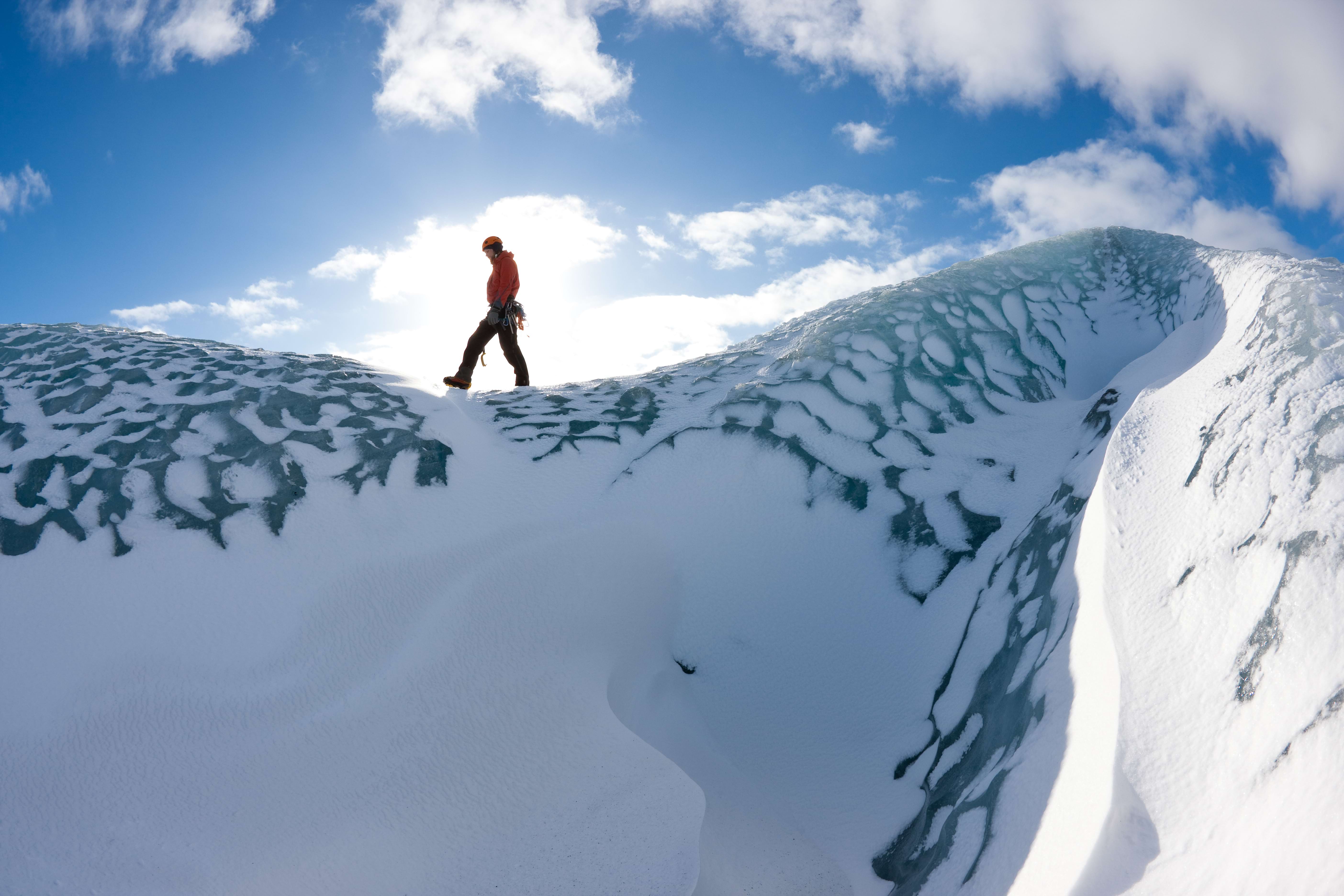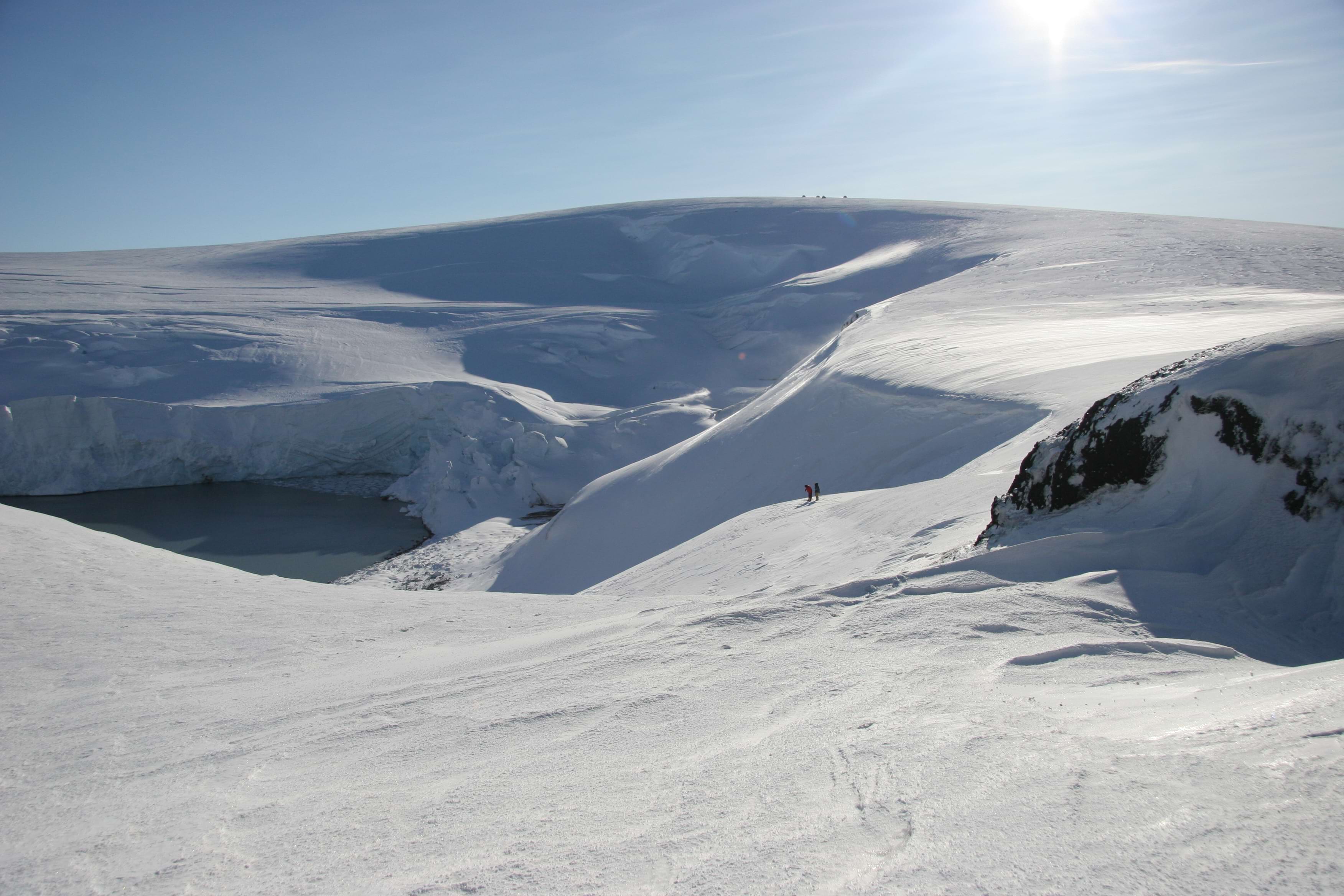Iceland’s Glaciers

Introduction
How did Iceland get its name? After all, it might be the “Land of Fire and Ice,” but it’s never been called “Fireland”!
In fact, its first name was Snæland (Snowland), given by Naddodd, a Viking who discovered Iceland by accident while sailing between the Faroes and Norway.
Iceland’s name goes all the way back to the 9th century when one of the first settlers, Hrafna-Flóki Vilgerðarson, climbed the highest mountain above his camp and saw ice everywhere he looked.
Over a thousand years later, more than a tenth of Iceland is still blanketed by vast volumes of snow, and dozens of glaciers define its landscapes.
From deep in Iceland’s heartlands, glaciers sculpt the country, influence its climate, and create a kaleidoscope of colors as these juggernauts of ice change shape and direction with each passing season.
Why does Iceland have so many glaciers?
Glaciers are a compressed mass of dense ice layers that form when falling snow accumulates in layers, compacted by its own weight and gravity over thousands of years.
Close to the Arctic Circle and highly mountainous, Iceland offers ideal conditions for generating gigantic glaciers, with large areas of the country permanently buried under immense ice caps.
Iceland has more than 250 “named” glaciers, and each one is like a character in the national story, often providing a dramatic backdrop for the famous Saga tales.
Glaciers move and flow slowly around the country like slow-motion rivers, finding their way between mountains and volcanoes, providing an endless source of freshwater and fueling thousands of waterfalls.
Many Icelandic glacier sheets cover active volcano systems, perhaps protecting the country by holding back these fiery giants from more frequent explosions.
But when these volcanoes erupt underneath the glaciers, as they often do, they can create something called a jökulhlaup.
That’s the Icelandic word for an unstoppable avalanche of glacial meltwater and rocky rubble that will crush everything in its path, bending bridges and ruining roads.
You can see what that looks like if you take a South Coast tour to the Glacier Lagoon, passing the twisted remains of the Skeiðarársandur road bridge on the way!
Don’t worry - jökulhlaups are rare, and there are always plenty of advance warnings with nationwide monitoring stations.
At the end of the last Ice Age, about 12,000 years ago, the polar ice sheets began to retreat from Iceland, liberating the land beneath the ice.
Some find it amusing that Iceland is actually quite green most of the time, while Greenland remains very icy!
Why are glaciers important in Iceland?
The epic struggle between mighty forces when fire and ice collide is fundamental in forming Iceland’s ever-evolving natural landscapes.
Carving through volcanic rock, and creating fjords, valleys, and river systems, glaciers have shaped Iceland as they rise and fall through the ages.
Glaciers are a popular attraction for visitors to Iceland, boosting its reputation as the perfect place for sustainable tourism experiences.
Many of Iceland’s glaciers are easily accessible, offering visitors an unmissable opportunity to enjoy astonishing glacier hikes, thrilling snowmobile rides, and unique blue ice cave tours.
The looming influence of these incredible rivers of ice has inspired Icelandic folklore, culture, art, and heritage in many ways.
Glacial landscapes are often crucial in the famous Icelandic Sagas and folklore, such as “Njáls Saga,” set on the South Coast around Hvolsvöllur.
In addition, glacial areas are often home to the “hidden people” of Iceland, including elves, trolls, witches, and wizards.
Scientists and researchers flock to Iceland to study its ice caps, assessing the impact of climate change and the ever-changing relationship between the country’s glaciers and volcanic systems.
Looking at ice cores taken from deep inside an ancient glacier is like time travel, showing what the climate was like centuries ago and helping us understand today’s weather.
Vast amounts of freshwater are slowly released from glaciers, sending surging freshwater rivers to supply Iceland’s hydropower generators, providing inexpensive electricity for the country.
Where are Iceland’s glaciers?
Wherever you are in Iceland, you’re never far from one of its gigantic glaciers.
Sólheimajökull and Vatnajökull are easily visited on South Coast tours, while Snæfellsjökull dominates the scene on Snæfellsnes trips.
And if you visit the Glacier Lagoon at Jökulsárlón, you’ll see the edges of Breiðamerkurjökull, from where the icebergs calve into the lagoon.
Here’s more information on some of Iceland’s most incredible glaciers!
Vatnajökull (the “Glacier of Lakes”) is Europe’s second largest glacier. It extends across 8,000 square kilometers in southeast Iceland and conceals several volcanic systems under its frosty bulk.
It’s also one of the youngest glaciers, formed about 2,500 years ago, during the Little Ice Age, with ice fields nearly a kilometer deep in places.
Iceland’s highest peak, Hvannadalshnúkur, can be seen on the southern edge of the glacier, which is part of one of Iceland’s three National Parks.
Dozens of “outlet glaciers” reach down from Vatnajökull, which is so large that it generates its own weather system, with cold winds blowing off the ice cap to chill the valleys below.
Sólheimajökull (“the Glacier where the Sun lives”) is one of the easiest glaciers to visit in Iceland, just a couple of hours away from the capital on the South Coast.
Part of the mighty Mýrdalsjökull ice cap and the Katla Global Geopark, Sólheimajökull is the perfect place to take a guided glacier hike and experience the incredible icy formations for yourself.
Close to the famous waterfalls at Seljalandsfoss and Skógafoss, Sólheimajökull offers spectacular scenery from a viewing platform if you don’t want to walk on the ice itself.
And you can see the astonishing effect of volcanic eruptions on Iceland’s landscapes here, with multi-colored layers of ice mixed with black ash from the 2010 Eyjafjallajökull eruption.
Climate change has seen Sólheimajökull retreat several meters over the last few years, creating its own “glacier lagoon” at its leading edge, but with much smaller ice fragments than the more famous Jökulsárlón.
Langjökull is Iceland’s second largest glacier, located close to the capital in West Iceland and easily spotted on clear days during Golden Circle tours.
A popular destination for snowmobiling, ice cap hikes, and the fantastic “Into the Glacier” experience, Langjökull covers almost a thousand square kilometers.
Mýrdalsjökull looms above the pretty South Coast village of Vík and the black sand beach at Reynisfjara.
It’s one of the largest and thickest glaciers in the country, and it covers the fearsome volcano Katla (Kettle), which erupts on average every 60 years. Katla last let loose in 1918, so it’s a little overdue now!
Öræfajökull (the “Wasteland Glacier”) is Iceland’s largest active volcano and ice cap. In 1362, an enormous tephra eruption, estimated to be the largest in the world for a thousand years, destroyed the entire area.
Breiðamerkurjökull is not far away, and it feeds the most famous sight in southeast Iceland, the Glacier Lagoon at Jökulsárlón.
The glacier tongue used to reach down to where the Ring Road runs before starting to shrink about 80 years ago. The Glacier Lagoon is now Iceland’s deepest lake.
As the glacier retreats inland, immense icebergs calve from Breiðamerkurjökull and sail serenely around the lagoon before scattering in fabulous fragments across Diamond Beach.
Further west, Snæfellsjökull is a spectacular 700,000-year-old stratovolcano on the tip of the Snæfellsnes peninsula, capped by a vast glacier nicknamed the “Pyramid of Eternal Snow.”
The “Snow Mountain Peninsula” is a mystical place, made famous by Jules Verne’s classic book, “Journey to the Center of the Earth.”
What are ice caves?
These glittering geological gems are formed when meltwater runs underneath the glacier, carving out a unique path for itself.
Ice caves are a natural seasonal phenomenon, displaying the tremendous forces of Icelandic nature and constantly changing color and shape.
You can see these fantastic glacial features on guided tours with glacier experts and kitted out with all the necessary safety gear.
Why is the ice blue? It’s because of the density of glacier ice. Blue has the shortest wavelength on the color spectrum. Other colors get absorbed by the ice, but blue doesn’t.
Visiting Iceland’s glaciers and ice caves
The only recommended way to visit Iceland’s glaciers and step on the ice yourself is by booking snowmobile tours, ice cave tours, or glacier walks with expert guides.
Do not attempt to explore glaciers or ice caves on your own!
Glacier crevasses and ice caves constantly melt and refreeze, creating mesmerizing maze-like structures. Only professional guides know how to navigate these icy landscapes.
Pack appropriate clothing (waterproofs, layers, etc), wear sturdy shoes, and ensure your phone is fully charged so you can take lots of photos (bring power packs if you have them).
The physical features of Iceland’s glaciers can change between morning and afternoon, especially in the summer, when the warmer temperatures cause the glacial ice to melt more quickly.
That means it’s an entirely different experience every time. No one else will ever see the glacier and the ice caves like you do!
The Future of Iceland’s Glaciers
Climate change has had a notable effect on Iceland’s glaciers, with almost all measurements showing them reducing in size or retreating further inland.
For example, Okjökull in West Iceland is no longer recognized as a glacier after losing much of its bulk and mobility, with an official ceremony marking its passing in 2019.
The loss of glacial ice could lead to isostatic land lift, with less weight holding Iceland’s rumbling volcanoes under control.
That could release more volcanic activity currently suppressed by glaciers, with unpredictable effects on freshwater supply, climate, wildlife, sea life, and the wider environment.
Glaciers symbolize Iceland’s natural marvels and are essential to its climate, culture, and heritage.
Make the most of your time in Iceland by taking a closer look at one of its icy marvels!
